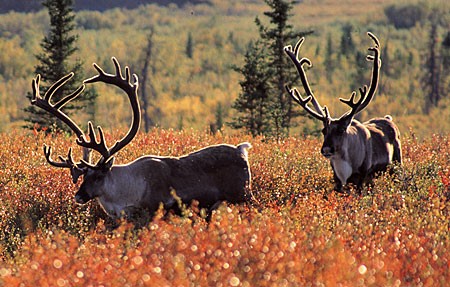Topics - Alaska
Alaska
Caribou

Caribou, sometimes referred to as reindeer, are endangered mammals in North America, largely due to habitat loss as a result of human development and climate change.1 Caribou prefer the treeless tundra of Northern Alaska and migrate south in the winter to the boreal forests. There are approximately 750,000 wild caribou in Alaska, and population changes are unpredictable given disease, climate, and predation factors.2
Native Alaskans have depended on caribou for sustenance for thousands of years. For some Native Alaskans, caribou are a part of their diet, similar to any other game, fish, or foraged plants. However, other Native Alaskans are inextricably linked to the caribou, and rely on caribou for every aspect of their life, including, but not limited to, shelter, clothing, and food.3
As the climate warms, caribou will be more susceptible to new diseases and need to adapt to the changes in their habitat. Their migration patterns may change, or they may stop migrating altogether, as is expected with other migratory animals under a changing climate. Should caribou populations begin to decline more than presently, Native Alaskans who have lived with the caribou and relied on them for millennia will likely be placed under hunting restrictions which could be detrimental to their way of life.
Sources:
- Conservation Northwest. (2020). Mountain Caribou. Conservation Northwest. Available online from: https://conservationnw.org/our-work/wildlife/mountain-caribou/ [accessed July 25, 2023].
- Alaska Department of Fish and Game. (N.D.). Caribou. Alaska Department of Fish and Game. Available online from: https://www.adfg.alaska.gov/index.cfm?adfg=caribou.main [accessed July 25, 2023].
- NPS. (November 2021). Nunamiut: The Caribou People. NPS. Available online from: https://www.nps.gov/articles/000/nunamiut-the-caribou-people.htm [accessed July 25, 2023].
CONNECT WITH US
Nikki Cooley
Co-Director
Nikki.Cooley@nau.edu
Karen Cozzetto
Manager
Karen.Cozzetto@nau.edu
Your tax deductible donation supports ITEP’s programming efforts.
Please contact us if you would like to contribute to our endowment or for any additional information regarding donations.

